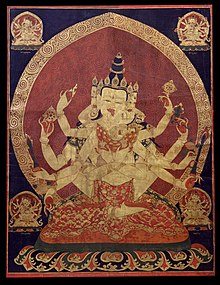Guhyasamāja Tantra

| Part of a series on |
| Vajrayana Buddhism |
|---|
 |
The Guhyasamāja Tantra (
: rgyud phyi ma), Toh 443, is sometimes considered to be its eighteenth chapter. Many scholars believe that the original core of the work consisted of the first twelve chapters, with chapters thirteen to seventeen being added later as explanatory material.The Guhyasamāja-tantra is not to be confused with the Mahayana sutra titled
In India, it was classified as a Yoga or Mahāyoga Tantra. In Tibet it is considered an Unexcelled Yoga Tantra (rnal ’byor bla med rgyud). It develops traditions found in earlier scriptures such as the Compendium of Reality (Sanskrit: Sarva-tathāgata-tattva-saṃgraha; De bzhin gshegs pa thams cad kyi de kho na nyid bsdus pa (Toh 479)) but is focused to a greater extent on the
The Guhyasiddhi of Padmavajra, a work associated with the Guhyasamaja tradition, prescribes acting as a Saiva guru and initiating members into
Origin
According to one tradition, the Guhyasamāja
As with most tantras, there are different traditions and transmissions. Perhaps the oldest surviving lineage is the
Iconography

There are two main commentarial traditions on the Guhyasamāja Tantra, the
In the practice of the
In the
See also
- Vajrayana
- Dakinis
References
- ^ Chandra, Lokesh, and Ratnam, Perala (Editors). Studies in Indo-Asian Art and Culture, Volume 5 International Academy of Indian Culture, 1977, pp. 114-115.
- S2CID 163276534.
- ^ Sanderson, Alexis. "The Śaiva Age: The Rise and Dominance of Śaivism during the Early Medieval Period." In: Genesis and Development of Tantrism,edited by Shingo Einoo. Tokyo: Institute of Oriental Culture, University of Tokyo, 2009. Institute of Oriental Culture Special Series, 23, pp. 144-145.
- ^ True Enlightenment Education Foundation, Taiwan. "The Secret Sexual Consort of a Tibetan Buddhist Lama—the first Kalu Rinpoche" Published:2012/06/25.
- ^ "Making the Old New Again and Again: Legitimation and Innovation in the Tibetan Buddhist Chöd Tradition", Michelle Janet Sorensen. Submitted in partial fulfillment of the requirements for the degree of Doctor of Philosophy in the Graduate School of Arts and Sciences. COLUMBIA UNIVERSITY 2013.
- ^ "VERY FINE ANTIQUE TIBETAN CITIPATI MASK" Strange Import.
- ISBN 9781932476019)
Further reading
- Guhyasamaja Practice in the Arya Nagarjuna System, Volume One, Shambhala Publications, 2019, ISBN 978-1559394857
- Fremantle, Francesca (1971), A Critical Study of the Guhyasamāja tantra (PDF), archived from the original (PDF) on 2014-08-26, retrieved 2014-08-23
- Wedemeyer, Christian K. 2007. Āryadeva's Lamp that Integrates the Practices: The Gradual Path of Vajrayāna Buddhism according to the Esoteric Community Noble Tradition. New York: AIBS/Columbia University Press. ISBN 9780975373453
- Geshe Tashi Tsering p. 78 of 240 July 3, 2012. Tantra: The Foundation of Buddhist Thought Volume 6. London: Wisdom Publications. ISBN 9781614290117
- Brilliant Illumination of the Lamp of the Five Stages, Columbia University Press, 2011, ISBN 978-1-93-501100-2
- A Lamp to Illuminate the Five Stages, Library of Tibetan Classics, 2013, ISBN 0-86171-454-7
